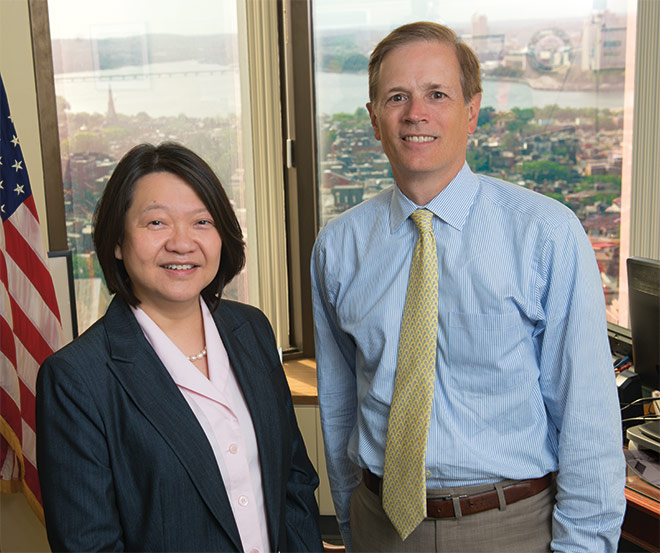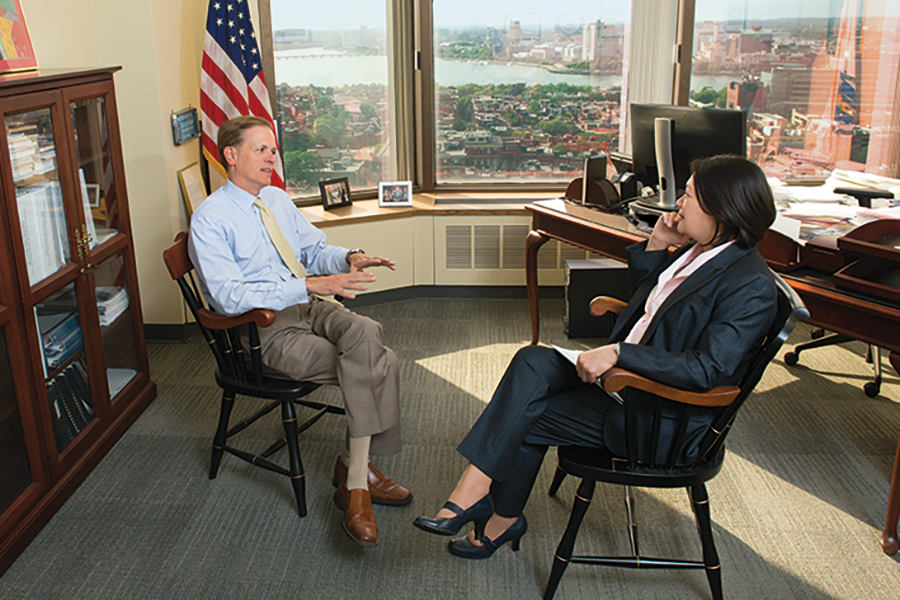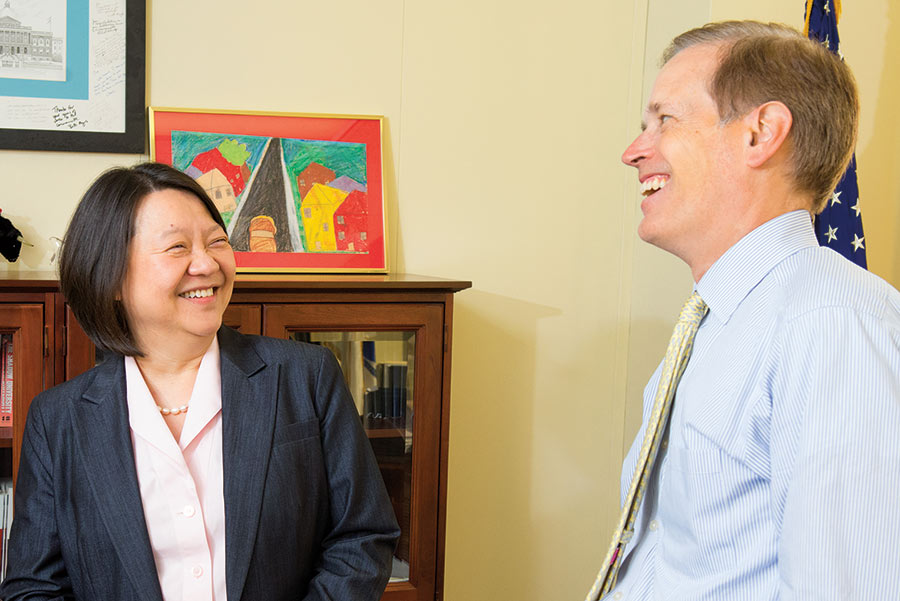
THE INTERVIEW
BHCC President Pam Eddinger Interviews Massachusetts Secretary of Education Jim Peyser.
President Eddinger Interviews Jim Peyser
President Pam Eddinger:
You’ve served as Secretary of Education for close to a year now. Does your experience so far match your expectations?
Secretary Jim Peyser:
Yes and no. I’ve been in and around state government in jobs similar to this one, so many of the issues are familiar. As a K-12 guy, I figured I’d be spending most of my time on K-12 issues. So far, that hasn’t always been the case. I’ve probably spent more time familiarizing myself with higher education issues. The governance structure of higher education is more challenging than K-12’s from a policy point of view. The policy-making apparatus is much more about relationship-building and collaboration, which takes time.
PE:
In these conversations with stakeholders, what surprises you? What inspires you?
JP:
I was at an event in Holyoke recently and somebody said, “We are activity rich and system poor.” There’s some incredibly inspiring work that’s happening every day in all levels of education. But the whole doesn’t always add up to more than the sum of its parts. So my primary focus is to create a strategic context so the work going on at campuses is producing a system of higher education to serve the whole commonwealth effectively. My other major priority is improving strategic connections between K-12 and higher education.
PE:
The idea that educational segments should not be silos has dominated national discussions on education. K-12 should reach for K-14, and K-14 ought to be reimagined as K-16. Are you seeing these movements in Massachusetts?
JP:
Yes, we are beginning to see movement within the state. I want to find the things that work and grow them. Overall, we’re producing great results—for example, our early college and dual enrollment programs. But, we have too few of these pathways for students. What’s most exciting for me is finding opportunities for growth in places where we’re already succeeding.
PE:
In my third year as BHCC President, I am seeing rapid expansions of these conversations with the Boston Public Schools and the Chelsea Schools. Do you think it’s because the conversations about career pathways and urban coalitions are converging?
JP:
I hope so. The dual enrollment program we have right now has largely been seen as a student-driven choice program. That’s great, but it’s not maximizing the value of those resources. We should be in vesting more in structured early college programs that work with cohorts of students—especially in STEM fields.
PE:
It sounds as though you really want to see more intentional support.
JP:
Absolutely, especially for high-need, low-income, first-time college students. We need to help these students stay on track to college and provide the support and infrastructure to help them finish.

PE:
I am in absolute agreement! Let’s talk about the education and business/industry connection. We have been responding to business and industry in a number of ways. For example, working with the Massachusetts Competitive Partnership on the Learn and Earn paid internships, or conducting incumbent worker training for career advancement with Beth Israel Deaconess Medical Center. Boston Public Schools Superintendent Tommy Chang recently asked a really thoughtful question: “With all of this work on partnerships, what are we promising our students at the end of the line?” One of my colleagues, Keith Motley, Chancellor of UMass Boston said, “Certainly with all of the skills and competencies we are training them for, they will be job ready.” My question for you...do we want them to be job ready or do we actually want a job waiting for them?
JP:
It’s probably both. Community colleges especially need to be in the relevancy business, and that means preparing young people and adults for work. It also means trying to create those kinds of connections before they get out of college, as with the Learn and Earn at Bunker Hill. If the employers could lead, that would be even better. Typically it takes a community college to organize the resources and the employers.

PE: The more successful community college programs have invited the employers into the process not only as provider of jobs, but as co-facilitators of learning. The mentors in Learn and Earn workplaces are really key to our success. Case in point, we have a partnership with the Department of Revenue (DOR) that was created to address the critical shortage of workers in that department. It’s a specialized certificate program that includes DOR internships and creates a pathway for a job either at the DOR or at an accounting or tax firm. I’d like to see more of that type of program in our commonwealth.
JP: That is easier to do in the context of a city or a region that has large employers who are able to make commitments to offer a number of positions year after year. We’re not taking full advantage of that.
-Secretary Peyser
PE: Distance education—or asynchronous education as we sometimes call it—has been around in higher education for close to two decades now. There are a lot of folks who believe it is the solution to access and to the student debt dilemma. Do you?
JP: I think it is part of the solution. For students who have a higher level of academic preparation, having online options either as a part of or as an entire course of study can be tremendously successful. I don’t think it is for everyone. I do think adding an online component to the typical college experience is not only a way to make it more affordable, but also to make it fit more easily into a person’s complicated schedule. Obviously, it depends very much on the content and the quality of the platform, but there are students who can really take advantage of it.
PE:
That is insightful because we are finding that on our campus. About a third of our students are taking online courses, usually one or two, in addition to the three or four they’re taking on the ground. Taking a full load of five classes is a challenge for our students because many work full time or have other obstacles. Students can’t finish in two years unless they’re taking five classes a semester, so we’re hoping that online offerings give them more options.
JP:
So much of this is providing different pathways through the college experience. Especially in an open enrollment institution like our community colleges, there’s no way you can say, “Here’s the program. You’re welcome to come and join, but this is it.”


PE:
That is insightful because we are finding that on our campus. About a third of our students are taking online courses, usually one or two, in addition to the three or four they’re taking on the ground. Taking a full load of five classes is a challenge for our students because many work full time or have other obstacles. Students can’t finish in two years unless they’re taking five classes a semester, so we’re hoping that online offerings give them more options.
JP:
So much of this is providing different pathways through the college experience. Especially in an open enrollment institution like our community colleges, there’s no way you can say, “Here’s the program. You’re welcome to come and join, but this is it.”
PE:
What do you think about college affordability and how it might be implemented?
JP:
College affordability has several components. First, we need to make sure that we’re doing everything possible to maximize the value and impact of the assets we have. Among other things, that means working collaboratively across college campuses to share resources and find economies of scale. By doing so, we can help moderate tuition and fee increases. Second, we need to make sure we are getting students through their college experience as quickly and efficiently as possible. This includes ensuring incoming students are better prepared for college-level work and improving the efficacy of developmental courses. It also means effective and proactive counseling to help students take the courses they need—and only the courses they need—to meet their academic and professional objectives. This also implies an ability to transfer credits from one college to the next throughout the public higher education system in all relevant majors. And finally, we need to develop lower-cost pathways for students, which allow them to get from point A to point B at below list price
PE:
When we sit down in a couple of years, what three big things would you like to see at our community colleges?
JP:
First, I’d like to see detailed, regional plans among all the institutions of higher education in a particular geographic area that are well connected and aligned with the workforce system. We need to make sure we’re maximizing the assets and resources we have at our disposal. Second, I’d like to see the development of new pathways for students starting in K-12 and working through college. Community colleges may need to take the leadership role here. We need to ensure not only that more students, especially first-generation students, are getting to and through college, but also that they are preparing for careers that can sustain them and their families. Third, we need to have a more rational and predictable means of financing higher education
PE:
You’re obviously an educator through and through. So on a really bad day, when your world is going every which way, what gets you up in the morning to do this work?
JP:
There are some tremendous people working in the field of education in Massachusetts. We need to support them and make them successful. That’s what I feel I'm here to do.

